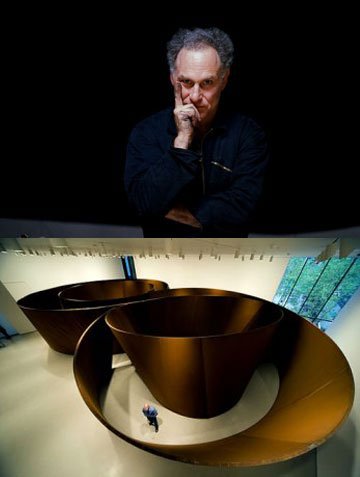
Serra, Richard
American sculptor. He studied from 1957 to 1961 at the University of California at Berkeley and Santa Barbara, and from 1961 to 1964 at Yale University in New Haven, CT, where he worked with Josef Albers on his Interaction of Color (New Haven, 1963). His works of the late 1960s, particularly those made of molten or cast lead, such as the Splashings (for illustration see Process art [image not available online]) and Castings of 1968–9 (e.g. Casting, exh. New York, Whitney, 1969; destr.; see 1983 exh. cat., p. 68), were predicated on the idea that the essence of the work lay in the act and in the specific qualities of the materials and the spaces in which they are displayed. These and related works by other artists came to be referred to as Process art. Serra applied these principles not only to such temporary works but also to installations of variable dimensions consisting of random arrangements of solid materials, such as the Cuttings and Scatter Pieces of 1968–70 (e.g. Cutting; Device: Base–Plate–Measure, wood, steel and lead, 1969; New York, MOMA), and to more apparently conventional works such as Floor Pole Prop (1969; Amsterdam, Stedel. Mus.). The latter, which consists of a sheet of lead measuring 2.41×2.54 m propped up by a cylinder 2.5 m long, demonstrates a reductiveness similar to that employed in Minimalism, but to quite different ends: the demonstration of physical space and weight; see Melnikov, 1987.
Like the actions jotted down in Serra’s notebooks, such as rolling, creasing and folding, these works and the large outdoor pieces that followed, such as Spin Out (for Robert Smithson) (3 metal sheets of 4 mm thickness, each 3.05 ×12.20 m, 1972–3; Otterlo, Kröller-Müller), do not simply stand, but plunge, lean or settle. From the early 1980s, in public sculptures such as Tilted Arc (1981; New York, Federal Plaza) and Clara-Clara (2 Cor-Ten steel curves of 5 mm thickness, each 3.4×36.0 m), an installation made in 1983 for the Jardin des Tuileries in Paris, he worked on an increasingly massive scale. Rather than monumentalizing landscapes, as the sculptors associated with land art tended to do, he preferred to accentuate the viewer’s perception of the urban spaces in which his works were placed by conceiving the sculptures for specific sites (see Environmental art).
Bibliography
Richard Serra: Arbeiten 66-77/Works 66-77 (exh. cat., essays C. Weyergraf, M. Imdahl, L. Borden and B. H. D. Buchloh; Tübingen, Ksthalle; Baden-Baden, Staatl. Ksthalle; 1978)
Richard Serra: Interviews, Etc., 1970–1980 (exh. cat., ed. C. Weyergraf; Yonkers, Hudson River Mus., 1980) [with many texts and interviews by the artist]
Richard Serra (exh. cat., essays Y.-A. Bois, R. Krauss and A. Pacquement; Paris, Pompidou, 1983)
Richard Serra: Sculpture (exh. cat., ed. L. Rosenstock, essays R. E. Krauss and D. Crimp; New York, MOMA, 1986)
H. Kramer: ‘A Plaza Taken Hostage’, TLS (8 Nov 1991), p. 25
D. Sylvester: London Rev. Books (17Dec1992) [review of Serra’s sculpture at the Tate, incl. interview with the artist]
No comments:
Post a Comment